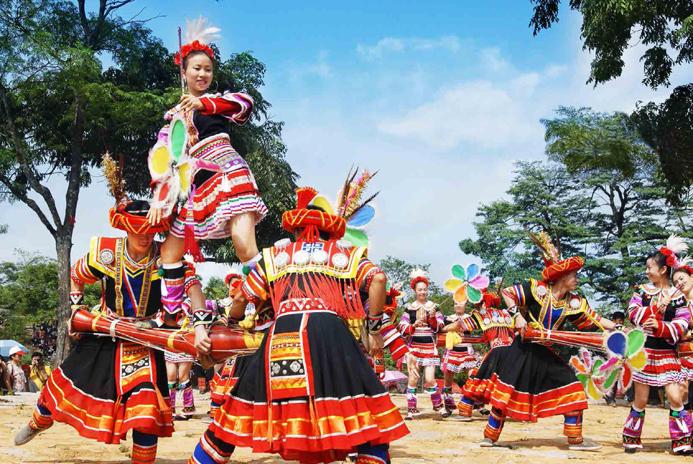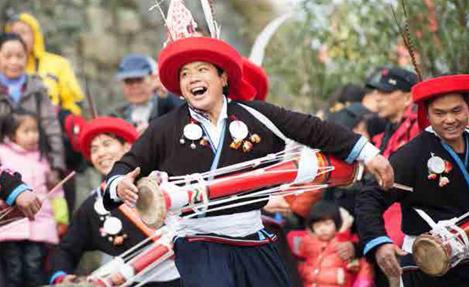Experience Different Cultures of the March 3rd Festival
2018-05-14ByWuSheng
By Wu Sheng



Sanyuesan Festival, or March 3rd Festival, is collectively observed by many nationalities in China, including Han and ethnic minorities such as Zhuang, Dong, Miao, She, Li and Yao. In modern days, the March 3rd Festival has been more than a day for spring outing or singing folk songs as in the past, but involved many colorful celebration activities of several Chinese nationalities. It is not only an event that promotes Chinese national cultures, but also a witness to the prosperous ethnic development across China. As cultures may vary among nationalities and regions, now we will give you a glimpse of some special celebration activities for the March 3rd Festival.
Grabbing firecracker ball of Dong people
The March 3rd Festival is one of the biggest traditional festivals for Dong nationality. According to a Dong legend, in the past, Dong people always considered the blossom of tung trees as the farming season. However, there was surprisingly no blossom one year on the tung trees, which caused the delay of the farming time, and thus compelled Dong people to escape their hometown as a result of widespread famine. Having learned the lesson from this awful experience, Dong people began to play Lusheng and sing songs across the whole village to remind each other of the approach of farming time, praying for favorable weather and fruitful harvests for the coming year. And the March 3rd Festival is said to be evolved from such customs.
Known as the “oriental rugby” or “Chinese rugby”, firecracker ball is an archetypal and captivating celebration activity for Dong people during the March 3rd Festival. Grabbing firecracker ball is a folk sport game with strong ethnic features, and has a firm and strong base in the masses of Dong nationality. The firecracker ball is made with bamboo strips or rattan, and outside the ball is a red piece of cloth tied up frmly with red and green silk threads. There are three firecracker balls in the game, “Facai (fortune) firecracker ball”, “Tianding (birth of boys) firecracker ball” and “Ruyi (smooth going) firecracker ball”, all representing auspiciousness. Literally speaking, “Facai firecracker ball” means making a big fortune or achieving great success in business; “Tianding firecracker ball” can ensure the birth of boys to grabbers family; and “Ruyi firecracker ball” can ensure the smooth going in every aspect of the grabbers life, including the wellness of his family members, bountiful harvests, and enduring happiness.
This activity is usually held in level open space. When a host declares the beginning of the game, the ball will be put on the gun muzzle and then be shot into the air. On hearing the gunshot, the athletes will vie for the ball, and all at once, the audience break into deafening cheers. Sometimes the firecracker ball may fall on to the ground, sometimes into the pond or onto the cliffs, the roofs or the branches, but wherever it falls, athletes will do their best to get it.
It in no ways means the end of the game when someone gets the firecracker ball. The grabber has to send it to the judging platform in the scrambling for it among the athletes and defeat others all. As the grabber succeeds in sending the ball to the designated place, bells and drums will be played together immediately to announce the winner.
Ganba Festival of Yao
The March 3rd Festival is also known as the Ganba Festival by Yao people, especially Landian (Indigo) Yao people, who reside in the mountainous areas of south and southwest China. The Ganba Festival is celebrated in memory of Pan Gu, the ancestor of Yao ethnic group.
Legend has it that long time ago, the ancestors of Yao ethnic group faced grave threats from wild beasts that often invaded Yao villages, hurt villagers and damaged crops. In order to defend their homeland, a courageous man named Pan Gu led some brave villagers to hunt the beasts in the mountain. Unfortunately, he was killed by an antelope with its horn jabbing in his abdomen. The day of his death was right on the third day of the third lunar month, as a result, the Yao people decided to hold celebrations on this day to remember their national hero.
Before the festival, young men in the Yao villages will go hunting in the forests and catch fish and shrimps by the rivers, and their game will be roasted into ganba (dried-up food); women will pick natural dyes such as indigo leaves in the mountain to make colorful glutinous rice (usually red, yellow, blue and purple) to worship Pan Gu. In the evening of the festival, the Yao people will gather together in a vast space, sharing the fruits of their labor, and singing and dancing around bonfires, and the whole villages will be immersed into a joyful atmosphere.
Drum is an integral part of Yao culture. The bronze drum, with historical significance, means memorizing ancestors and praying for bumper harvest for Yao people. Therefore, it is natural that the bronze drum dance is more than a traditional folk dance, and more importantly, a highlight in Yao peoples celebration activities. Dressed in traditional costumes with distinctive ethnic features, dancers will stand in lines or form a circle, and dance to the rhythm of the bronze drums, which are led by a large wood one in the center of the dancing pool. There are several forms of bronze drum dance, and circle dance represents a typical one. During this kind of dance, young Yao men and women will dance in a circle, hand in hand, which symbolizes unity, solidarity and close bonds. With the earsplitting drum sounds, Yao people dance and sing to express their joy of harvests in the previous year and beautiful wishes for next year.
In some villages of Yao, people sing and dance hand in hand around a maple tree, a traditional totem of Yao ethnic group, to show their respect to ancestors and the nature. Accompanied by the sonorous drums and lingering lusheng (reed-pipe instrument), Yao people are bound to each other closer. Definitely, it epitomizes the essence of Yao peoples faith and gives a glimpse into the core of Yaos spiritual life.
